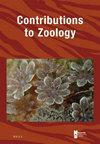Applying geometric morphometrics in megalopa larval stages: relevance for species distribution and biological invasion studies
IF 2.1
2区 生物学
Q1 ZOOLOGY
引用次数: 0
Abstract
Larval morphology in brachyuran crabs is an essential trait defining survival in the planktonic environment. The present study describes the morphology (carapace and chelipeds) of megalopa larvae in three different species (Percnon gibbesi, Cronius ruber, and Achelous hastatus) using geometric morphometric analysis (gma). The study aim was to compare the observed body patterns at interspecific and intraspecific levels. The results showed a marked interspecific distinction of C. ruber larvae based on the rostral region of carapace and cheliped length. We relate these differences to advantages in life performance, as in other animal models, suggesting that larval morphology can be another factor contributing to the invasiveness of C. ruber. At intraspecific level, we found a high morphological similarity between two distant geographical locations, indicating strong genetic connectivity in the populations of P. gibbesi from the Canary Islands. Our findings advance the importance of larval morphology for species performance during the plankton phase that eventually can determine invasiveness in brachyuran crabs. We suggest future studies focusing on the inter-population comparisons of megalopa morphology at larger spatiotemporal scales.在巨蜥幼虫阶段应用几何形态计量学:对物种分布和生物入侵研究的意义
糠虾蟹类幼体的形态是决定其在浮游环境中生存的重要特征。本研究利用几何形态计量分析(gma)描述了三种不同物种(Percnon gibbesi、Cronius ruber 和 Achelous hastatus)巨螯蟹幼体的形态(甲壳和螯足)。研究的目的是比较在种间和种内观察到的身体形态。研究结果表明,根据喙区的躯壳和螯足的长度,C. ruber幼虫具有明显的种间差异。与其他动物模型一样,我们将这些差异与生活表现的优势联系起来,表明幼虫形态可能是导致 C. ruber 入侵性的另一个因素。在种内水平上,我们发现两个遥远的地理位置之间存在高度的形态相似性,这表明加那利群岛的 P. gibbesi 种群具有很强的遗传连通性。我们的研究结果推进了幼体形态在浮游生物阶段对物种表现的重要性,最终可决定臂蟹的入侵性。我们建议未来的研究侧重于在更大的时空尺度上对巨蟹幼体形态进行种群间比较。
本文章由计算机程序翻译,如有差异,请以英文原文为准。
求助全文
约1分钟内获得全文
求助全文
来源期刊

Contributions to Zoology
生物-动物学
CiteScore
4.00
自引率
4.50%
发文量
16
审稿时长
>12 weeks
期刊介绍:
Contributions to Zoology solicits high-quality papers in all systematics-related branches of comparative zoology (including paleozoology). Preference will be given to manuscripts dealing with conceptual issues and to integrative papers (e.g., ecology and biodiversity, morphology and phylogeny and character state evolution, phylogeny and historical biogeography, systematics and bioinformatics, bioinformatics and biodiversity, habitat disturbance and biogeography, etc.). Reviews and alpha-taxonomic contributions are considered for publication, but acceptance will depend on their high quality and exceptional nature.
 求助内容:
求助内容: 应助结果提醒方式:
应助结果提醒方式:


